Electoral systems across the UK
The devolved legislatures are elected using different voting systems to the first-past-the-post system. How do they work?
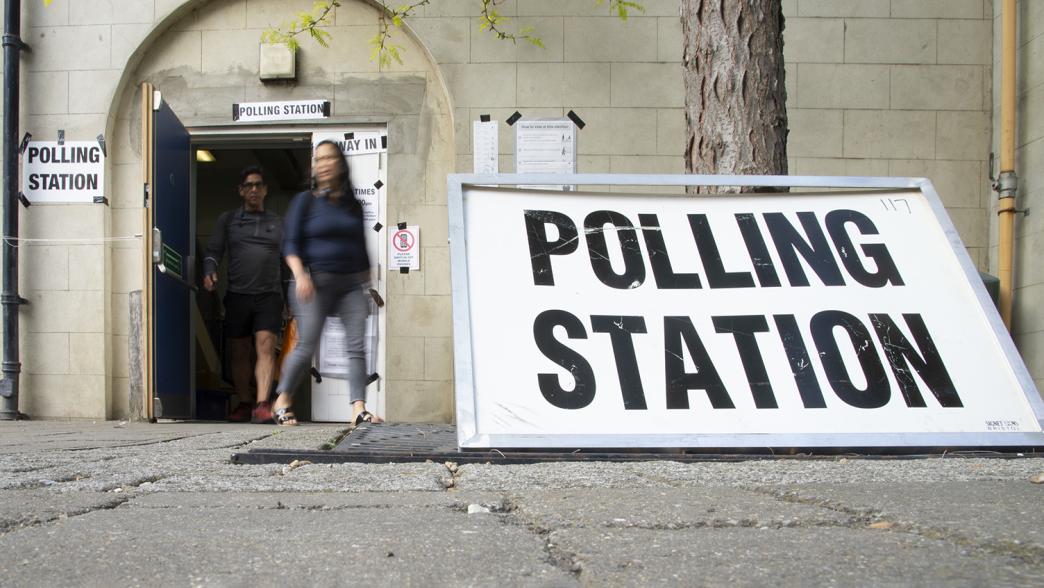
The devolved legislatures in Northern Ireland, Scotland and Wales are elected under voting systems that differ from the first-past-the-post (FPTP) system used in UK general elections.
All three use a type of proportional electoral system. The Scottish parliament and Senedd Cymru (Welsh parliament) are elected under versions of the ‘additional member system’ (AMS); and the Northern Ireland assembly uses the ‘single transferable vote’ (STV).
Unlike the parliament in Westminster all three devolved legislatures are unicameral, with one legislative chamber.
In 2016 and 2017, the power to reform the electoral system, electoral franchise and size of the devolved legislatures was devolved to Scotland and Wales, subject to support of two-thirds of members. The Northern Ireland assembly cannot reform its own electoral system.
|
|
UK general election (Westminster) |
Scottish parliament |
Welsh parliament / Senedd Cymru |
Northern Ireland assembly |
|---|---|---|---|---|
| System | First past the post (FPTP) | Additional member system (AMS) | Additional member system (AMS) | Single transferable vote (STV) |
| Number of seats | 650 | 129 | 60 | 90 |
| Voting age | 18+ | 16+ | 16+ | 18+ |
Scotland
Scottish parliamentary elections use the additional member system (AMS). Voters in Scotland each have two votes; the first vote is for a constituency member, the second for a party on a regional basis.
The constituency vote uses the same first-past-the-post counting method that is used in Westminster elections; the candidate with the most votes in that constituency wins the seat. There are 73 members elected in this way.
The second vote acts as a top up vote providing ‘additional members’ to the parliament from regions across Scotland. There are 56 members elected this way to represent eight parliamentary regions with seven seats available in each region. Voters cast their vote for a party (or independent) in their region. Any parties contesting a region publish a fixed list of candidates.
This stage is described as ‘topping up’ because it allocates additional seats to parties or independent candidates according to the number of regional votes cast, while taking into account how many constituency seats the party won in the region. A party that wins a disproportionate share of constituency seats may therefore not win any additional regional seats, even if it wins the largest number of regional votes.
Party seat entitlement for the regional members is determined through the d’Hondt formula. 6 Wilson H.J., 'The D’Hondt Method Explained', Mathematics Department, UCL, https://www.ucl.ac.uk/~ucahhwi/dhondt.pdf. For the party that wins additional seats, the first name on their list is elected to the first additional seat, proceeding down the list if more seats are won.
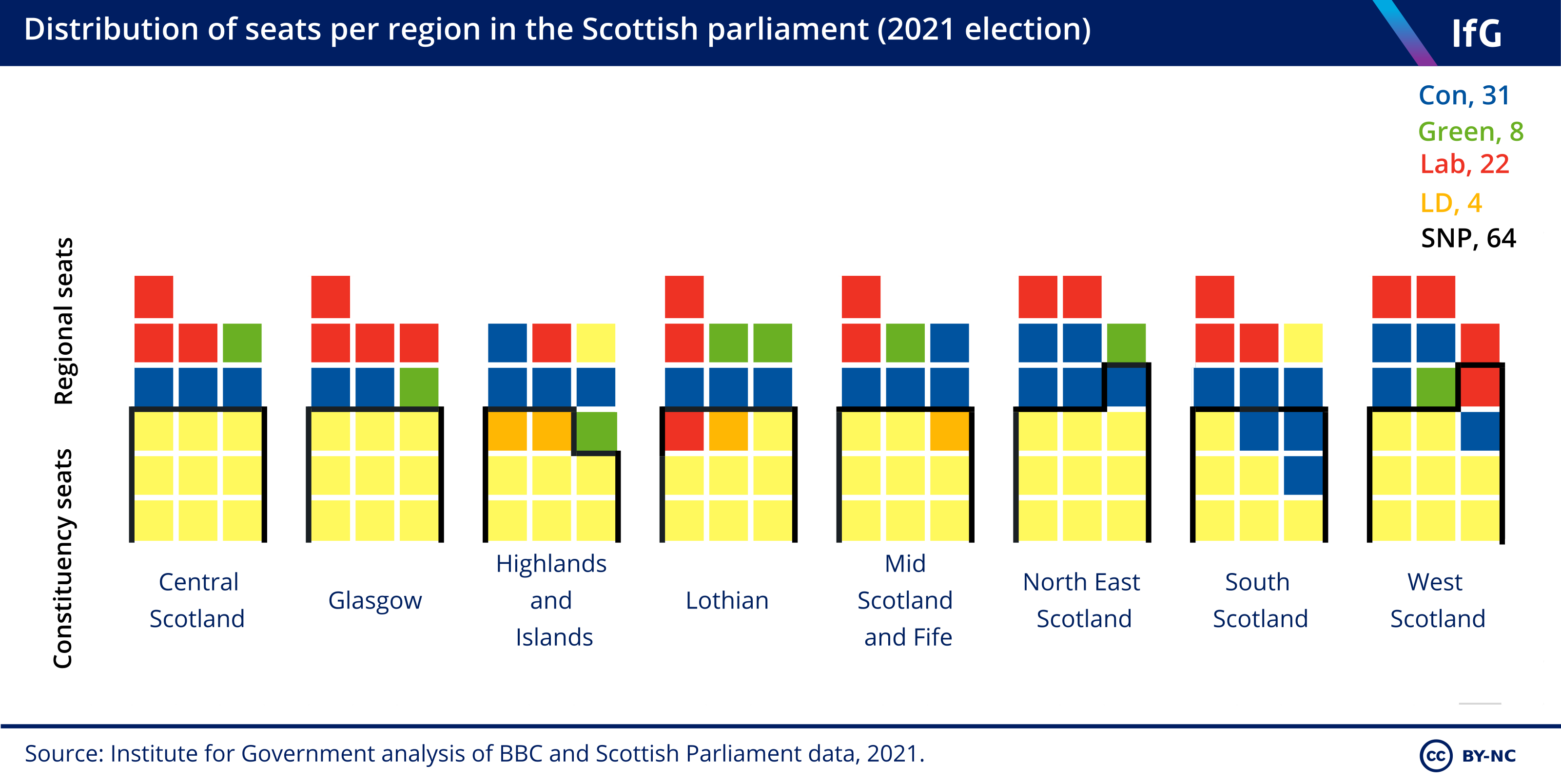
Wales
Elections to the Senedd Cymru also use AMS. As in Scotland, voters in Wales therefore cast two votes.
The first vote is for constituency members: 40 members of the Senedd (MS’s) are elected in this way. The second for regional members: 20 MS’s are elected in this way. Wales has five electoral regions, each covering between seven and nine constituencies. Four members are elected to represent each region.
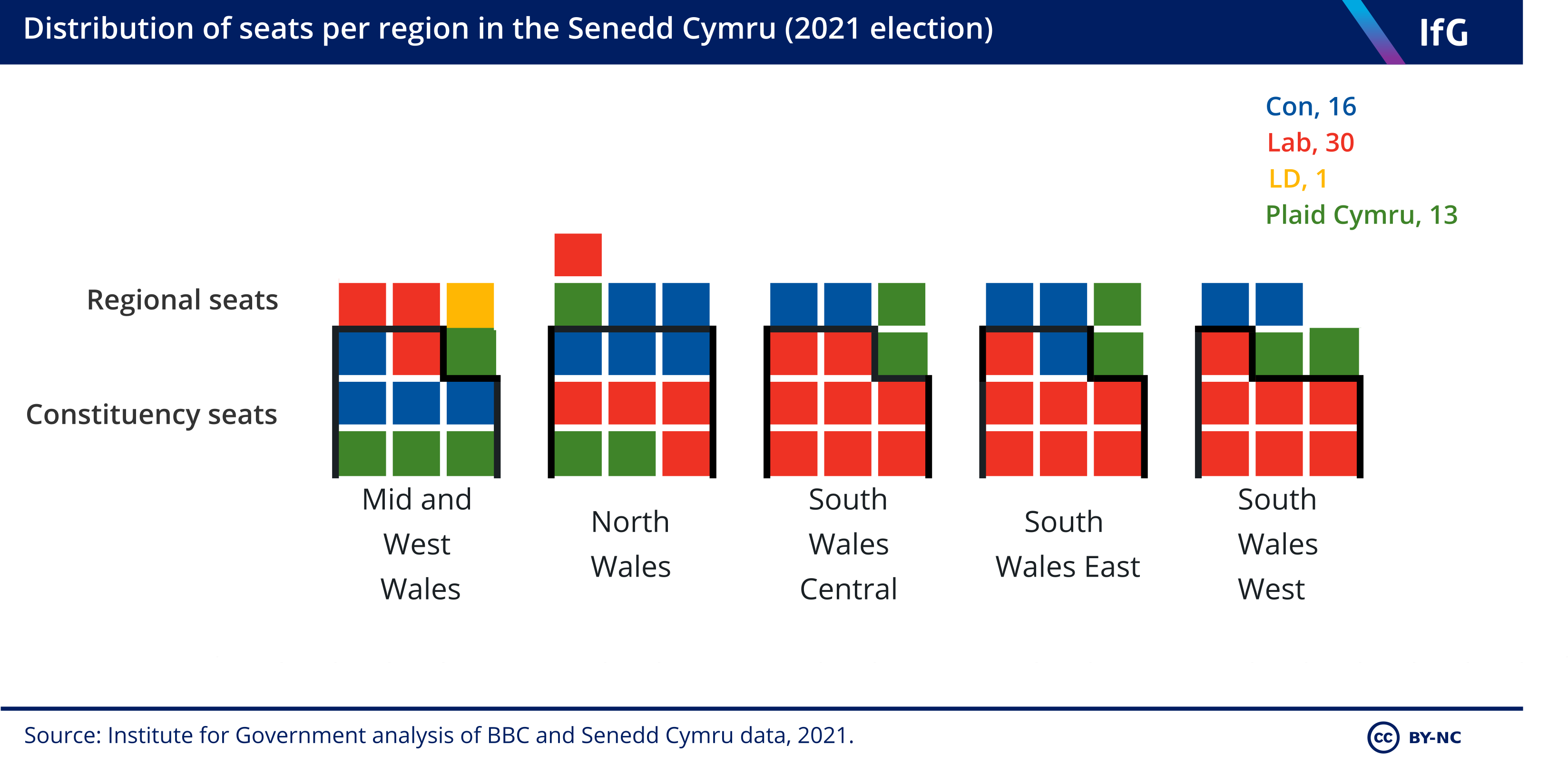
Northern Ireland
The Northern Ireland assembly in Stormont was established following the Belfast/Good Friday Agreement signed in 1998 and was designed to facilitate power-sharing between unionist and nationalist parties. The assembly comprises 90 members who are elected using the ‘single transferable vote’ (STV) system.
Under STV, all members are elected in the same way and are elected to represent multi member constituencies. The 18 constituencies are the same as those used in UK general elections with five members elected from each. Parties can put forward as many candidates as they like in a constituency – in 2022 a total of 239 candidates stood in the election.
Voters are presented with a list of candidates and list their preferred candidates in order by writing 1 (first choice), 2 (second choice), 3 (third choice) etc. next to the name of as many or few candidates as they wish. To gain a seat a candidate needs to receive a certain amount of votes (the quota) which varies across constituencies. The 'droop quota’ is calculated by dividing total votes cast by 1 more than the number of available seats, then adding 1.
When a candidate has exceeded the quota other votes for them are surplus votes. These are transferred to voters’ next preference candidate. Instead of transferring specific ballot papers, a representative transfer value is calculated (see box below). The candidate(s) with the fewest votes are also eliminated and their votes redistributed. If a voter’s second preference is already eliminated their next available preference is used.
At each stage candidates who receive transferred votes and exceed the quota are elected, and further candidates are eliminated. Any surpluses, and the votes the eliminated candidates received, are then redistributed. The process continues in this way until all the seats are filled.
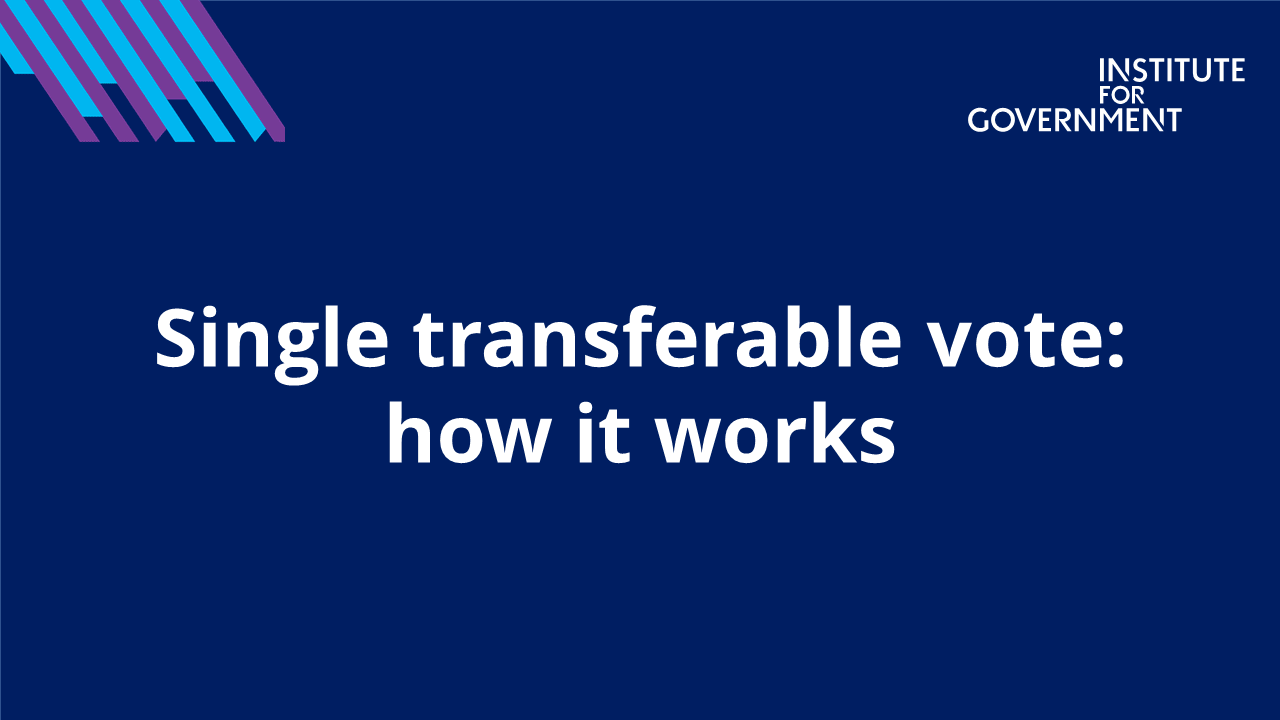
How are the votes transferred to a second preference?
When there is a surplus of votes for a candidate (i.e. any above the droop quota), a representative transfer value is calculated. This is done by dividing the surplus by the total number of votes cast for that candidate that have a second choice marked. This fractional value is then transferred to the second preferences.
The candidate(s) with the fewest votes are also eliminated and their preferences redistributed. If the second preference is an eliminated candidate, the next available preference is used. The transfer value for these votes is one vote, as the first preference was not used.
If a surplus arises at a later stage (i.e. not the initial count of first preferences), then the representative transfer value is only calculated for the last batch of votes that got the candidate over the quota. 8 Trinity College Dublin, Election indices, www.tcd.ie/Political_Science/people/michael_gallagher/ElSystems/Docts/ElectionIndices.pdf
Example:
John Smith receives 1,000 first-preference votes.
The droop quota is worked out to be 800, so John Smith is elected immediately.
John Smith has 200 surplus votes. All of the ballot papers that have him as first choice also have a second preference marked (although this is unusual in real-life cases).
Representative transfer value: 200 / 1,000
Value: 0.2
600 of John Smith’s votes had Jane White as their second preference, so Jane receives 120 redistributed votes (600 x 0.2)
200 had Mark Green as their second preference, so Mark receives 40 votes (200 x 0.2)
200 had Maria Black as their second preference, so Maria also receives 40 votes (200 x 0.2).
Who can vote in different parts of the UK?
The franchise differs across the devolved legislatures. In Scotland and in Wales the voting age for parliamentary elections is 16; in Northern Ireland (as for UK general elections) it is 18.
British, Irish, or qualifying commonwealth citizens are eligible to vote in UK general elections. In Northern Ireland the qualification is expanded to include those who are legally resident in the country with EU citizenship. In Scotland and Wales this is expanded further to include anyone legally resident regardless of their nationality.
What are the effects of the different electoral systems across the UK?
The systems used in the devolved legislatures are designed to produce more proportional results; the number of seats each party wins more closely reflects its share of the vote. The result is that single-party majorities are rare. The Gallagher index is used to measure proportionality across different system, on a scale of 0 to 100 a score closer to 0 indicates more proportional outcomes.
Comparing the devolved legislatures since devolution in 1999 the Northern Ireland assembly’s STV system is the most proportional, the Scottish parliament and the Senedd are slightly less proportional (in that order). All are more proportional on average than UK general elections.
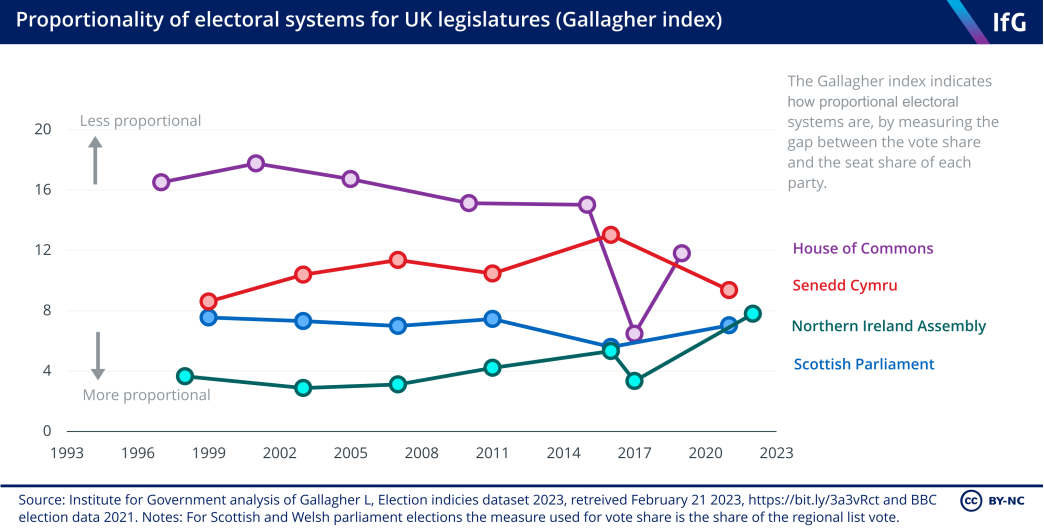
What proposals are there for reform of the devolved electoral systems?
In May 2022 the First Minister of Wales and the leader of Plaid Cymru (who have a co-operation deal with the Labour government) issued a joint statement setting out plans for electoral reform.
The key reforms proposed are to increase the size of the Senedd from 60 to 96 and to replace AMS with a closed regional list system with 16 multi-member constituencies. Each of these constituencies will be formed of two of the 32 new Westminster constituencies due to be introduced in 2023 as set out in the boundary review.
Under this system, the party will decide the hierarchy of candidates on the list – voters will not be able to express a preference for a particular candidate. Labour and Plaid Cymru also propose to introduce mandatory gender quotas by ‘zipping’ the list with men and women candidates included in alternate positions on the list.
It is expected that these reforms will be in place for the next Senedd election in 2026.
No proposals for electoral reform are currently being considered in Scotland or Northern Ireland.
- Keywords
- General election Leadership election
- United Kingdom
- Scotland Wales Northern Ireland
- Devolved administration
- Scottish government Welsh government Northern Ireland executive
- Legislature
- Scottish parliament Senedd Northern Ireland assembly
- Publisher
- Institute for Government